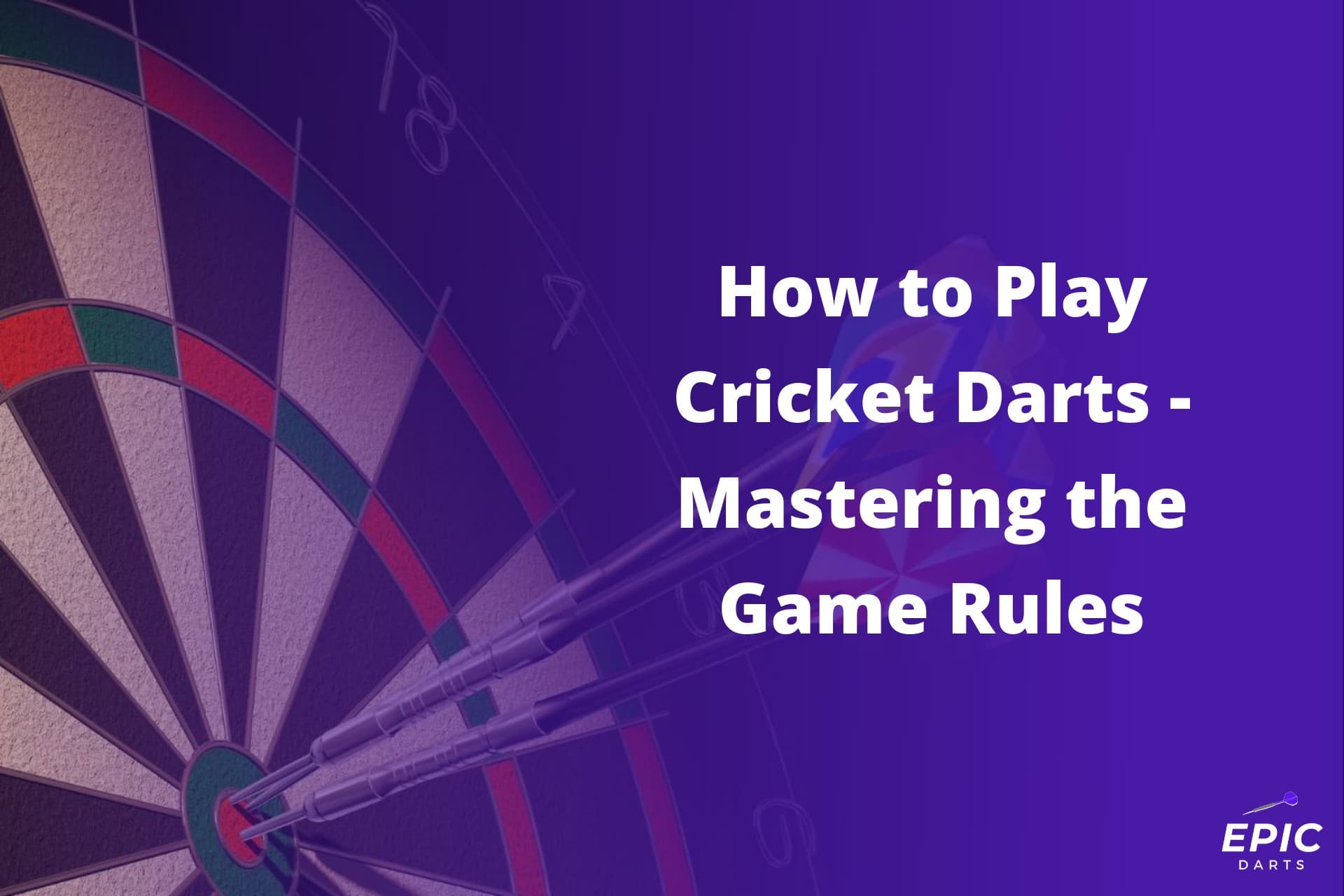Before you dive into the game of cricket darts, it is essential to understand its unique set of rules and gameplay. Unlike traditional darts, cricket involves a different scoring system and requires specific strategies to win. Whether you’re a seasoned player looking for a fresh challenge or a newbie testing your dart-throwing skills, cricket can be an engaging choice.
Very briefly, here’s how a typical game of cricket darts is usually being played:
- Cricket darts is played on a standard dartboard, but only numbers 15 through 20 and the bullseye are actually used.
- Each player or team takes turns throwing three darts.
- The goal is to “close” all the numbers (15 through 20) and the bullseye by hitting them three times before your opponent does.
- Once a number is ‘closed’, you can start scoring points on it until your opponent also closes it.
- The player with the most points at the end, having closed all numbers and the bullseye, is declared the winner.
So, if you and your team are looking for a new challenge or want to try something different with your friends, give cricket darts a shot! It’s a game that requires precision and accuracy, just like a player aiming for the bulls eye. Get ready to hit the target and aim for the ring! It’s an exciting team game that tests your accuracy as a player and strategic thinking while aiming for the bulls eye. With endless hours of entertainment, this game challenges you to hit the target number and ultimately earn the ring.
Explanation of ’01’ and Cricket Dart Rules
Cricket darts is a popular game variation that adds an exciting twist and strategic element to traditional darts gameplay. The player aims to hit specific numbers on the dartboard, known as “rings,” to score points and ultimately win the game.
Overview of the game format ’01’
The ’01’ game format is a popular choice among cricket darts players. It involves players aiming to reach a specific score by throwing darts at a dartboard. The objective for the player is to reduce their score from an initial value, usually 501 or 301, down to zero as quickly as possible.
Each player takes turns throwing three darts per round. The player’s scores are deducted from their total until the player reaches zero. However, there’s a catch – players must finish their turn by hitting a double or the bullseye (inner circle) to win the game.
Detailed explanation of scoring in cricket darts
Scoring in cricket darts follows a unique system where certain numbers on the dartboard are designated as “open” or “closed.” The player can open or close the numbers 15 through 20 and the bullseye during gameplay.
To open or close a number, players must hit it three times with their darts. Once closed, any subsequent hits on that number will count towards the player’s score while denying points to their opponent. This strategic element adds depth and complexity to the cricket darts player.
Hitting triples (the narrow inner ring) or doubles (the wider outer ring) multiplies the score for that particular segment for the player. For example, if a player hits triple 20 with their first dart, it counts as 60 points instead of just 20.
Rules for starting and finishing a game of cricket darts
To start a game of cricket darts, players typically take turns throwing one dart at the bullseye. The player who gets closest to the bullseye goes first. If both players hit the bullseye or land equidistant from it, they can throw again until a clear winner is determined.
Once the game begins, players alternate turns and aim to score as many points as possible while strategically closing numbers on the dartboard.
To finish the game, players must reach zero exactly by hitting a double or the bullseye with their final dart. If a player overshoots and goes below zero, their score resets to what it was before that turn began. This rule adds an exciting element of pressure and strategy for the player during the final stages of a match.
Step-by-step Guide on Playing Cricket Darts
Choosing the Right Equipment for Cricket Darts
Having the right equipment is essential. To get started, you will need a dartboard and a set of darts. Dartboards are available in various materials such as sisal or cork, but sisal boards are recommended for their durability and self-healing properties.
You’ll want to consider the weight and style of your darts. Most players prefer darts weighing between 22 to 26 grams, but it ultimately depends on personal preference. Experiment with different weights and styles to find what suits you best.
Setting up the Dartboard for a Game of Cricket
To set up your dartboard for a game of cricket, follow these simple steps:
- Find an appropriate location where there is enough space for players to stand at least 7 feet away from the board.
- Mount the dartboard securely on a wall, making sure it is level and at the correct height – 5 feet 8 inches from the floor to the center of the bullseye.
- Mark out throwing distances using tape or markers on the floor to ensure fair play.
Once you have set up your dartboard correctly, it’s time to learn how to play cricket darts!
Step-by-Step Instructions on Throwing Darts Accurately in Cricket
- Begin by determining who goes first through a simple coin toss or any agreed-upon method.
- Each player takes turns throwing three darts per round.
- The objective is to score points by hitting specific numbers on the dartboard: 15 through 20 and bulls-eye (25).
- To “own” a number, you must hit it three times in total during the game.
- Aim for single segments initially until you gain accuracy before progressing towards doubles and triples.
- Utilize a consistent throwing technique, focusing on your grip, stance, and release.
- Practice aiming for different areas of the dartboard to increase your versatility and precision.
Throughout the game, keep track of scores using a scoreboard. You can use a simple pen and paper or opt for electronic scoreboards available in many darting apps or websites.
Remember, cricket darts is not just about scoring points but also strategic play. Use your darts strategically to prevent opponents from owning numbers while aiming to own as many numbers as possible yourself.
By following these step-by-step instructions and practicing regularly, you’ll improve your skills and become a formidable player in the exciting game of cricket darts!
Now that you have a grasp on how to play cricket darts, it’s time to gather your friends or join a local league for some friendly competition. Get ready to enjoy countless hours of fun and excitement as you aim for bullseyes and strive to outscore your opponents!
Understanding Bowlers and Batters in Cricket Darts
Cricket darts is an exciting game that combines the precision of darts with the strategy of cricket.
Roles and Responsibilities of Bowlers in Cricket Darts
Bowlers play a crucial role in cricket darts, aiming to hit specific areas on the dartboard to score points and ultimately win the game. Their primary responsibility is to strategically target certain numbers on the board, known as “innings.” Each inning represents a number from 15 to 20 and the bullseye.
To begin their turn, bowlers must hit each inning three times before moving on to the next one. The objective is to score more points than their opponent by hitting specific targets consistently. This requires skillful aim, control, and accuracy.
Strategies for Effective Bowling in a Game of Cricket Darts
To excel as a bowler in cricket darts, it’s essential to employ effective strategies that maximize your scoring potential while minimizing your opponent’s chances. Here are some key tactics you can utilize:
- Target Weak Innings: Identify which innings your opponent struggles with and focus on targeting those areas. By capitalizing on their weaknesses, you can gain an advantage.
- Controlled Bulls Eye: While hitting a bullseye grants you immediate points, it also opens up opportunities for your opponent to score heavily if they hit multiple bulls eyes (bulls eyes). Consider strategically avoiding or limiting bullseyes until advantageous moments arise.
- Strategic Placement: Aim for precise placements within each inning rather than simply hitting them randomly. For instance, focusing on hitting doubles or triples can significantly boost your scoring potential.
By implementing these strategies alongside consistent practice, you can enhance your bowling skills and increase your chances of victory.
Techniques and Tactics Used by Batters to Score Points in Cricket
Batters, on the other hand, have the responsibility of accumulating points by hitting specific areas on the dartboard. Their primary goal is to score as many points as possible while also preventing their opponent from doing the same. Here are some techniques and tactics utilized by batters:
- Scoring Bulls Eyes: Hitting a bullseye (bulls eye) grants batters immediate points and puts pressure on their opponent. Aim for consistent bullseyes to gain an advantage.
- Closing Innings: Similar to traditional cricket, batters aim to close innings by hitting each number three times before their opponent does. This prevents the opponent from scoring any further in that inning.
- Strategic Blocking: If your opponent is close to closing an inning, consider targeting that specific area to prevent them from achieving it. By blocking their progress, you can maintain control of the game.
The key for batters is to balance offense and defense effectively, consistently scoring points while hindering their opponent’s progress.
Enhancing Your Dart Game with Cricket Variations
Cricket darts is a popular game that adds an exciting twist to the traditional sport of darts. While the basic rules of cricket remain the same, there are several variations you can explore to enhance your dart game and add a new level of challenge and fun.
Exploring Different Variations within the Game of Cricket Darts
There are numerous variations that can spice up your gameplay. One popular variation involves changing the scoring system. Instead of using the standard scoring method where hitting any number on the dartboard earns points, you can modify it so that only certain numbers count towards your score. For example, you could focus on hitting doubles or triples instead of singles. This variation not only tests your accuracy but also encourages strategic thinking as you aim for specific areas on the board.
Another variation involves altering the target area on the dartboard. Instead of aiming for just any section on the board, players must hit particular regions such as the bullseye or outer bullseye to earn points. This variation adds an extra layer of difficulty and precision to your throws.
Tips for Adding Fun Challenges to Your Regular Games of Cricket
To make your regular games of cricket more enjoyable and challenging, consider incorporating these tips:
- Track scores in innings: Divide each game into multiple innings or rounds where players take turns throwing their darts. At the end of each inning, calculate scores and award points accordingly.
- Introduce team play: Form teams with friends or family members and compete against each other in a friendly tournament-style format.
- Set specific targets: Create additional challenges by setting specific targets for players to hit. For example, you could require players to hit a certain number of bullseyes or doubles within a given round.
- Implement time pressure: Add an element of urgency by setting a time limit for each player’s turn. This will test their ability to make quick decisions and maintain accuracy under pressure.
How to Adapt Your Strategy Based on Different Variations in Play
Adapting your strategy is crucial when playing cricket darts variations. Here are some tactics to consider:
- Focus on high-value areas: If the scoring variation requires hitting doubles or triples, prioritize aiming for those sections on the dartboard. This will allow you to accumulate points more quickly and put pressure on your opponents.
- Strategize against opponents: Observe your opponents’ strengths and weaknesses and adjust your gameplay accordingly. If they excel at hitting bullseyes, aim for other areas where they may struggle.
- Keep track of scores: Maintain a mental or physical record of scores throughout the game to identify which numbers need more attention. Concentrate your efforts on closing out those numbers before moving on to others.
Related Resources: Further Reading on Cricket Darts
Congratulations! You’ve now learned the basics of playing cricket darts. Armed with this knowledge, you’re ready to step up your game and start enjoying the thrill of cricket darts with your friends or at your local pub. Remember to practice regularly to improve your skills and aim for those high scores!
To take your cricket darts experience to the next level, consider exploring different variations of the game. From Cut Throat Cricket to Shanghai, there are numerous exciting twists that can add a new level of challenge and fun to your matches. So grab your darts, gather some friends, and let the games begin!
FAQs
How do I keep score in cricket darts?
To keep score in cricket darts, each player or team starts with a score of 40. The objective is to hit numbers from 15 to 20 and the bullseye three times each (known as “closing” those numbers). Once a number is closed by a player or team, they can earn points by hitting that number again while their opponent(s) try to close it themselves. The first player or team to close all numbers and have more points than their opponent(s) wins.
Can I play cricket darts alone?
Yes, you can play cricket darts alone! It’s called practicing solo or playing against yourself. Set up a dartboard at home and follow the same rules as if you were playing against someone else. This allows you to work on your accuracy and consistency without needing a partner.
What are some common strategies in cricket darts?
Some common strategies in cricket darts include focusing on closing specific numbers early on, aiming for triple segments for maximum points, strategically blocking your opponent(s) from closing their numbers by hitting them yourself, and going for bullseyes when you have an opportunity.
Are there any tips for improving my aim in cricket darts?
Yes! To improve your aim in cricket darts, practice regularly and focus on your hand-eye coordination. Experiment with different grips and stances to find what works best for you. Try to maintain a consistent throwing motion and follow through with your arm after releasing the dart.
What equipment do I need to play cricket darts?
To play cricket darts, you’ll need a dartboard, a set of darts, and a safe playing area. Make sure the dartboard is securely mounted on a wall or stand and that there is enough space around it for players to comfortably throw their darts without any obstructions.
Can I play cricket darts outdoors?
While it’s possible to play cricket darts outdoors, it’s important to consider the weather conditions and ensure that the dartboard is protected from wind or rain. If you have a suitable outdoor space with proper protection for the dartboard, playing cricket darts outside can add an extra element of fun to your game.





